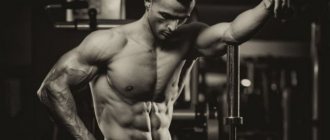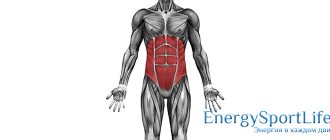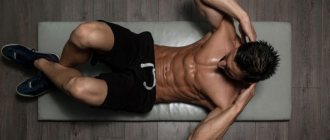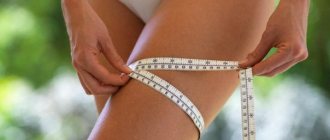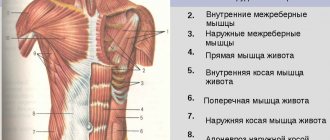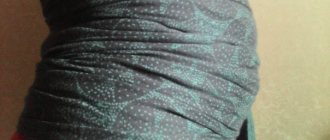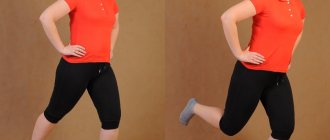Physiological structure and characteristics of the abdominal muscles?
Abdominal reconstruction involves the combined use of a properly formulated training system and diet. Often people forget about the importance of the second factor, because it is much easier to do a few sets in the gym or at home in the hope of seeing a six-pack on the stomach, than to follow a low-calorie diet for a long period.
Let's start with the main muscle for most people, abdominis muscle , which is what you see in glossy magazines among professional bodybuilders and fashion models. Additionally, the abs are surrounded by the external oblique and internal oblique abdominal muscles. The first ones are visible in people who have excellent dryness; the external obliques start from the armpits and end in the lower abdomen. Visually, they are visible and look like scratches left by a predatory animal.
Internal oblique muscles - there is no need to look at them, because they are located under the external obliques and even if you have a body fat percentage of less than 5%, you will not be able to see them. You can simply note that the internal oblique muscles are located at an angle of 90 degrees relative to the external obliques, and are the antagonists of these muscles.
Based on the aesthetics of the body, the rectus muscle and external obliques are of greatest importance to us, because these are the muscles that are visible when there is a minimum amount of fat in the human body.
Exercise and nutrition
Most athletes are concerned with the question of what exercises need to be done when working on relief. As stated earlier, they don't have to be too complicated. Classic ab crunches are ideal. But sooner or later there will come a time when these exercises become too simple for you. In this case, simply complicate their implementation: for example, when lifting your body, throw your legs onto a higher surface (chair, sofa or bench) and perform crunches in this position. Don't waste your energy doing light exercises that place less stress on your abs. It will not work to give your abs relief, and you will only waste your time and energy. Complicate the movements until the load becomes sufficient for you.
The following video presents popular exercises for abdominal relief:
Diet and aerobic exercise are no less important points in working on relief. Without them, you will not be able to achieve high results. Do aerobic exercise (running, swimming, jumping rope) 2-3 times a week. In addition, take care of your diet. In order to achieve sculpted abs, it is best to choose a protein diet that is high in protein and low in carbohydrates.
Source
What does it take to see abs on your stomach?
You can often hear this: “No matter how hard I work out my abs, no matter how many exercises I do, my abs still don’t become more visible, although it hurts quite a bit after each workout. I pump my abs 3 times a week, in each of the three exercises for 5 approaches, in each approach from 50 to 70 repetitions. Tell me, maybe I’m doing something wrong?”
To begin with, let's determine right away: the appearance of the abdominal press does not depend on the amount of work done on it, but it depends on the percentage of subcutaneous fat in your body. If your goal is the appearance of six-pack abs or the amazed faces of girls at the “presence” of six-pack abs on your stomach, then you need to follow the rules given below:
- You need to reconsider your nutrition system - remove or reduce the consumption of the following foods: sugar, sweets, flour (you can leave wholemeal bread), starchy carbohydrates, animal fats (lard, lard, butter, cream). It is necessary to increase the daily amount of protein consumed through the following products: low-fat chicken, low-fat cottage cheese, cod fish, you can use high-protein mixtures (with a protein content of 70-80%). This will protect your muscles from destruction due to reduced caloric intake. By the way, it will be useful to read an article about myths about absorbing the amount of protein at one time. Eat more vegetables.
- After strength training, do a 30-40 minute aerobic workout (treadmill, stationary bike, elliptical skier, you can use a jump rope). At the same time, make sure that the intensity of the workout is medium, because instead of burning fat, you will begin to perform cardio training.
- To enhance the fat burning effect, you can use L-carnitine or fat burning agents. Also suitable for these purposes are: caffeine, ephedra, guarana extract. They should be consumed immediately before training.
- Also, for better fat burning, and as a result, improving the appearance of the abdominal muscles, in order to reduce fluid retention in the body, it is necessary to reduce the amount of salt or salty foods consumed.
- If you want to improve your definition and bulge, remember that your abs are a muscle just like any other in your body. And to increase its volume, you need to do the same as with the rest of the muscles. Namely, pump your biceps or back with sets of 6 – 10 repetitions with heavy weights.
Also look at effective exercises to train your abdominal muscles.
For those who have a low level of subcutaneous fat, no sides and even visible abs, but no relief, I recommend working out using the system in this video. Here is an excellent complex that will help make your abs more prominent in 20 minutes a day.
For those who have a lot of subcutaneous fat, neither this nor any other set of exercises will help; you need to work in different directions to achieve results.
Now let's continue our discussion in more detail on the topic: how to achieve sculpted abs?
Anatomy of the abdominal muscles
It is this part of the abdominal cavity that we see because the rectus muscle is superficial and protrudes outward. Everyone around is only dreaming of becoming the owner of beautiful abs, this is where further actions end, as they say, the quality of the return is directly proportional to the quality of the delivery.
Structure of the abdominal muscles:
- a long muscle consisting of two halves located on either side of the abdomen;
- in the middle of the abdomen there is a line that consists of tendons;
- the line of tendons is 2 cm wide and extends along the entire abdomen, starting from the pubis and ending near the chest.
It should be noted that on the outer part of the abdominal cavity there are also bundles of tendons that cross the rectus muscle perpendicular to the location of the main muscle fibers.
It is this interweaving of fibers and tendons that we see on our stomach under the guise of a washboard. Now it becomes more clear that the main emphasis must be placed on one muscle, which will always work together, unlike other muscle structures. This is an important point for practical training of any part of the body. For example, when you bring a bottle of water to your mouth to quench your thirst, the entire biceps contracts, not individual parts. A similar contraction occurs in the rectus abdominis muscle when you perform twisting movements with your body.
An important point that needs to be read with special thoughtfulness so as not to repeat the mistakes of other people in the future. Almost every instructor talks about how you can pump up the upper abdomen first, and then the lower abdomen, or vice versa, without any problems.
“It is better to remember once and do not repeat useless actions: in nature there are no exercises that can load a specific part of the muscle. The rectus muscle can only be in two states: relaxed or contracted.”
Naturally, there are many abdominal exercises in which you change the vector of movement and slightly shift the emphasis to a certain part of the muscle. It should be noted that only professional bodybuilders need to work on the press from different angles; for the average person in the gym, this turns into a completely useless exercise.
All of the above is explained simply: “the load during an accentuated exercise on a certain part of the rectus muscle has a displacement angle of no more than 1-3%.” The difference is so minimal that you simply will not feel it. The abs, by their physiological structure, is one muscle that cannot be worked only in certain places. When performing any exercise, the abdominal muscles are involved in the work 100%, with a small vector of deviation in a certain part of no more than 3%.
Having touched upon the topic of how to pump up sculpted abs, it is impossible to avoid the question of why, during intensive work, the lower part of the abs lags behind in 90% of cases?
For men, developing and working out the lower part is quite difficult for two reasons, for women for three:
- If you look at it from an anatomical point of view, there is simply nothing to train in the lower abdomen. From a physiological point of view, the rectus muscle is most developed in the upper part, starting from the navel and ending with the thoracic region; at the point of attachment near the pubis, the muscle is formed from thin tissue.
- Even visually, the advantage of the upper press is clearly visible. This physiological superiority is essential to provide functionality to the core and perform twisting work. That is why the top of the press is more adapted to intense load than its lower part.
- Nature has taken care of the fair half of humanity, and in order to reduce pain during the menstrual cycle, a woman’s lower abdomen has reduced sensitivity and fewer nerve endings than men. This is why the lower part of the abs in women does not respond well to intensive training.
The knowledge gained can be effectively applied when compiling a training complex, but some conclusions need to be listed now:
- The press is always fully involved in the work and contracts along its entire length, regardless of the chosen exercise.
- It is much more difficult to develop and effectively load the lower part of the press than the upper part.
- Remember that there is no need to use a lot of exercises to train your abdominal muscles.
- If you train the lower abs with emphasis, the upper muscles will receive an even load.
Ab relief program
Clear waist lines and defined abdominal muscles are the dream of every man and woman. But not everyone knows how to give their abs definition without exhausting themselves with training.
Unfortunately, not everyone can achieve sculpted abs and defined lines, due to serious mistakes.

How to train properly to make your abs visible?
Diet for sculpted abs!
For fat burning to occur, you must adhere to a low-carb diet. You need to understand that getting rid of fat is a biochemical process that promotes the breakdown of triglycerides into fatty acids. This is why subcutaneous fat cannot be shaken, crushed, melted or squeezed out of its cellular structure.
Based on the above, we can say with 100% confidence that any physiotherapeutic procedures: bathhouse, massage and others do not burn subcutaneous fat. These activities are designed to solve two narrowly focused problems:
- improving blood saturation of fat cells;
- increase – microcirculation in muscle fibers.
Do not believe newfangled advertisements and friendly beauty salon administrators that the above measures can rid you of subcutaneous fat. Only a low-calorie diet, with the help of which you will accelerate the dormant metabolism and force the body to use fat as a consumable material for the life support of the muscle structure and internal organs.
Exercises for abdominal relief!
Let us tell you a secret: to build up your abdominal muscles, you need to train them just like other parts of the body. However, choosing the right exercises for training the rectus muscle is much easier than for a bulky muscle group. Because it performs a fairly simple twisting function. Understanding this makes it possible to exclude 80% of the exercises used for the abs from the training system. You can choose the most effective abdominal exercises from the list if you want to diversify your workout.
Main functional features of the rectus muscle:
- direct pulling of the upper body downwards;
- or twisting the pelvis towards the torso.
That is why it is necessary to select exercises that will most accurately repeat the functional ability of the rectus muscle and the above-described vector of movement. Two exercises fall into this category:
Crunches – REVERSE AND LYING.

1. LYING TURNS - this is a basic exercise for developing the abs. If you have problems with constant lack of time, use only this exercise, because lying crunches allow you to contract your abs through the maximum range of motion. There are many options for performing the exercise:
- Roman chair; - lying on the floor; - or using an incline bench.
Accordingly, the lower your torso is located in relation to your legs, the greater the load on the rectus abdominis muscle, the more difficult it is to perform and the amplitude of movement increases.
Complicated technique for performing the exercise to ensure maximum effect:
1. Leg position . A common and easy form of performing the exercise is to position the body lying on a horizontal surface, with the legs bent and elevated.
To complicate the movement, you need to bend your legs on the floor without using additional elevation. Keep in mind one nuance: the farther your heels are from your buttocks, the more difficult and effective the exercise becomes.
2. Hand position. Most people use a lighter version of the exercise and place their hands closer to their stomach, this makes it possible to significantly reduce the twisting moment.
He will try to gradually move his hands away from his stomach, placing them as the load increases, first on the chest, behind the ears and the back of the head, the further the hands are, the more addition he will perform repetitions.
3. Surface slope . Try to position your head and torso below your relative pelvis, this will help achieve a good burning sensation while doing crunches. We would like to give you some practical advice: if you place a bolster or pillow under your lower back when performing the exercise, you can increase the range of motion and contraction of the rectus abdominis muscle. To ensure growth, constantly increase the complexity of lying crunches using the methods described above, alternating simpler ones with more complex ones and vice versa.
2. REVERSE CURLS - this is a completely opposite and inverted way of working the rectus muscle relative to ordinary lying crunches. In this exercise, the pelvis is already twisted in relation to the person’s torso. It is for this reason that there is an opinion that such a movement works the lower abs. Surely each of you knows more than one option for performing the exercise described above: lifting your legs while lying on the floor, hanging on the crossbar with a powerful movement, bringing your legs to your head - these are all reverse twisting and their various modifications.
1. You need to position yourself on the floor so that there is a support for your hands at the level of your forehead. This will ensure good fixation of the torso and reproduction of twisting movements only due to the vertical work of the hips.
For example, the edge of the bed can serve as a good support; the whole point is to rest your hands well. If you neglect this, you will not be able to lift your pelvis up vertically.
2. The main task when performing crunches is to raise the pelvis in a vertical position. Remember not the legs, but the pelvis. Many trainers make a common mistake and advise their trainees to lift their legs directly to the body, forgetting that the functional characteristics of the rectus muscle do not include lifting the legs. Remember once and for all, the main function of our press is to lift and twist the pelvis from different positions.
Then a completely logical question arises: why load the rectus muscle indirectly, if this can be done accentuated with the help of the pelvis. Of course, the legs will rise a little when performing repetitions, the main thing is not to aggravate it, as 90% of those training in the gym do.
3. When you have taken a comfortable position on the floor, you need to forget about your legs and completely concentrate on lifting your pelvis. To ensure maximum concentration, you can bend your legs at the knees.
Difficulties and technical nuances when performing reverse crunches! 1. Leg position. A more difficult version of crunches involves straightening your legs and keeping your heels away from your pelvis. If you are just starting to practice this exercise, use a lighter version of it and bend your knees as much as possible and bring them closer to your chest.
2. Surface slope. If your torso is located significantly higher than the pelvis (lying position on an inclined bench), this will complicate the performance of crunches due to the large amplitude of movement. And naturally, the low position of the body will significantly facilitate the twisting effect due to the smaller amplitude of movement. That is why it is difficult to bring your legs to your head on the bar.
How to pump up sculpted abs? Top exercises.
Pumped up abdominal muscles are one of the most desirable body parts for every athlete. It seems like everyone wants them, but only a few have them. Do the following exercises and your stomach will turn into stone abs! Athletes work their butts off in the gym, performing countless sit-ups and crunches, only to end up with sore muscles and diminished motivation.
On the subject: Exercises for the rectus abdominis muscle for women
The standard crunch is performed while lying on the floor, feet flat on the ground, and arms either crossed in front of you or behind your head. Bend your upper torso toward your knees, keeping your lower back off the ground, just your upper torso. Squeeze your abdominal muscles and exhale as you rise. Hold this position for a second, then return to the starting position, keeping your abdominal muscles tense.
2. Raising the body from a lying position.
To perform sit-ups, take the same starting position, then lift your entire upper body toward your knees. Return to the starting position. Try to use your abdominal muscles rather than your lower back when lifting.
3. Twisting on a fitball.
There are many different variations of this exercise, such as crunches on an exercise ball, with your feet on a bench and with a small plate on your chest for weight.
4. Raising the body on an inclined bench with weights.
A great way to make the sit-up more challenging is to do it on a bench with a negative incline while holding a weight plate with your arms crossed over your chest. This is quite difficult, so try it with light weights first.
5. Lifting the legs while lying down.
Leg raises are performed while lying on your back on the floor, with your arms slightly out to the sides and your palms flat on the floor for support. Keeping your feet together, lift them with your knees slightly bent until they are almost perpendicular to the floor. Lower your legs to the starting position, without, however, touching your heels to the floor, and repeat the exercise.
6. Incline leg raises.
Tip: To make it more challenging, perform leg raises on a bench with a negative incline. This will allow the range of motion to be wider and the muscle contraction will be more intense and effective.
7. Raising legs while hanging on the bar.
Straight or bent leg raises in a hanging position are two more exercise options for pumping up the steel muscles of the lower abs. While hanging on the bar, raise your legs straight or bent at the knees in the same way as in a lying position until they are parallel to the floor. Lower your legs. When lifting bent legs, lift your knees towards your stomach and lock. Lower your legs to the starting position.
Lie on the floor on your side with both hands behind your head and, if necessary, use a footrest to stabilize your lower body. Lift your body to the side without lifting your hips off the floor. Fix your body position at the top point for a second, then return to the starting position. Don't lie down. Switch sides and repeat the exercise.
One of the most effective exercises from the entire complex for the abs (especially for the oblique muscles) is the “bicycle”. It is quite complex, but if performed correctly it can guarantee excellent development of all abdominal muscles.
10. Side crunches “Bicycle”.
Lie on the floor, put your hands behind your head, lift your legs slightly off the floor. Start alternately reaching your elbows towards your knees. Rotate your torso so that your left elbow reaches your right knee and vice versa. Continue the exercise without your shoulders touching the floor. Squeeze your obliques with each contraction. Tip: You can make it more challenging and isolate one set of oblique muscles by focusing on one side first, then the other. Just complete all reps on one side first and then on the other.
With straight arms, hold a medicine ball or pancake in front of you. Start doing upper torso crunches, first to one side (as far as you can), then to the other. Continue the exercise at a slightly slow pace. Sudden jerks can lead to lumbar injuries. Tip: For those who find it difficult to perform an exercise with a ball or pancake, you can simply clasp your hands in front of you and continue to act in accordance with the standard technique. This way you can strengthen your muscles so that you can move on to weighted crunches in the future.
On topic: All abdominal muscles work
This exercise does not involve any movement and is used to strengthen and develop deep muscles. This stability exercise is used primarily to tone the transverse abdominis muscle. Just take a lying position, leaning on your palms or elbows. Draw in and tighten your abdominal muscles to engage your internal muscles. Hold this position for 20-30 seconds, then rest - this will count as one set.
Like a regular plank, this exercise develops the internal muscles, but only on both sides for lateral stability. Without bending your body, lie on your side, prop yourself up on your elbows, and keep your feet together. You can place your other hand on your waist or side. Hold this position for 20-30 seconds, then repeat on the other side. Tip: To make the exercise a little more challenging, try slowly switching from a side plank to a regular plank as you move to the other side. Make sure your body is aligned and perform the exercise smoothly and at an even pace.
Source
